The Lowdown
With its excellent display, Dolby Atmos speakers, great cameras, all-day battery life, fast MediaTek Dimensity 1200 processor, and IP53 splash resistance, the Xiaomi 11T is a great option if you are ready to try something new. Get to know Xiaomi; you’ll be glad that you did!
Overall
Pros
- Solid build
- Beautiful and bright 6.67″ AMOLED Gorilla Glass Victus display
- Excellent battery life
- Fingerprint reader built into the power button is very accurate and can be set for touch or press activation
- Facial recognition works very well
- Choice of 60Hz or 120Hz refresh rate
- Dual SIM
- IP53 dust and water resistance
- Xiaomi is promising three years of Android OS updates and four years of security patches
Cons
- No wireless charging
When I reviewed the 4G Xiaomi 11 Lite, I said that Xiaomi is a brand that more of us in the United States should become familiar with and pay attention to, and that has never been more true. The Xiaomi 11T and 11T Pro were announced in September; I have the 11T in hand, so let’s take a look at this affordable 5G smartphone, and see if it might be an option for you.
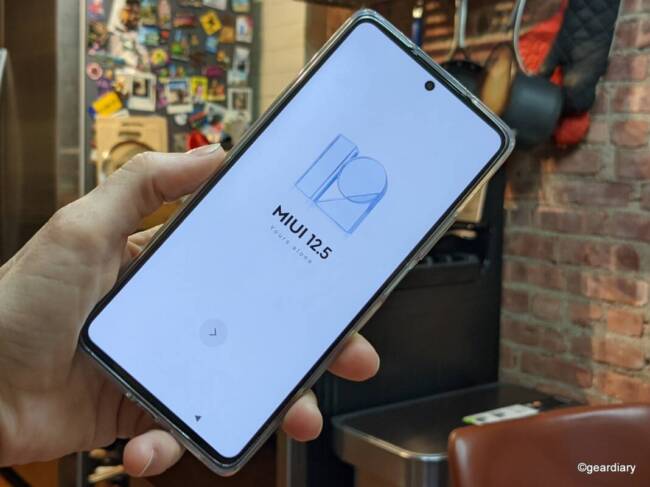
Offering just about everything that you might want from a flagship device without an exorbitant price, the Xiaomi 11T features a top-of-the-line MediaTek processor, a gorgeous display, Dolby Atmos sound, a 5,000mAh battery, 5G speeds, better than expected cameras with AI features, Wi-Fi 6, Bluetooth 5.2. and an IP53 dust and water resistance rating. It is definitely worth considering if you are thinking outside the box when considering a new smartphone.
The box includes the Xiaomi 11T, an EU fast charger, a USB Type-C to Type-C cable, a SIM Eject Tool, a clear protective case, a factory-installed screen protector, a quick-start guide, and a warranty card.
The Xiaomi 11T Hardware Walk-Around
The Xiaomi 11T measures 6.46″ tall by 3.03″ wide by 0.35″ thick, and it weighs 7.16 ounces; it has a beautiful, flat 6.67″ AMOLED display (2400×1080 with a 20:9 aspect ratio) with HDR10+ TrueColor. If you like a brighter display, you’ll appreciate that it can give you up to 1000nits of peak brightness with HDR10+ content.
The 11T also features 120Hz AdaptiveSync refresh rates for smoother scrolling and 480Hz touch sampling rates for less lag between your finger touching the display and the action you want to happen to occur.
The display is protected with top-of-the-line Corning Gorilla Glass Victus. In the top center of the display, there is a 16-megapixel selfie cam. Just above the speaker is the ~1″ wide ear speaker.
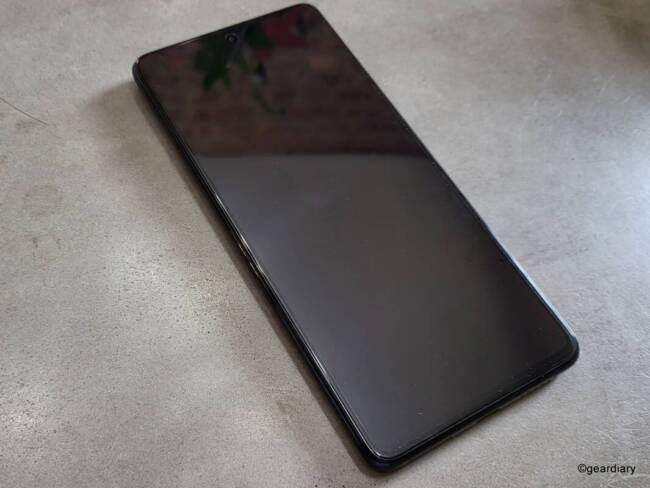
The Xiaomi 11T has lightly curved edges on the back, meeting the flat display on the front. At 3.03″ wide, the 11T is just a bit wider in hand than the 2.9″ wide Pixel 5a that I am used to carrying, but the tapered edges and 3D quad-curved back make it nestle comfortably in my hand. Even so, I suspect that a more petite person might find this phone just a little bit wide, so that’s something to bear in mind. I didn’t mind the width, and the 11T has a nice heft without being too heavy.
The bezels on the 6.67″ AMOLED display are nicely balanced, and the edge-to-edge display looks gorgeous and bright with vivid, clear colors. You’ll be able to choose from several display color scheme options, including Vivid (which is where I keep it set), Saturated, and Original Color. You can also set it to use Adaptive Colors based on the ambient light in your environment, and you can also manually adjust the color temperature so everything looks just as you’d like it.
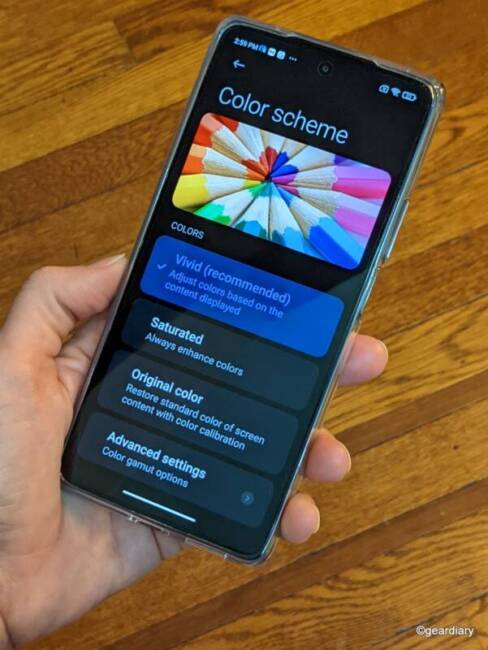
There is a microphone on the 11t’s top and the first of two Dolby Atmos speakers. You can see the edge of the factory-installed screen protector clearly in this photo; you’ve heard me say it before, but I really love it when companies send their devices out with this initial protection installed!

There is a power button with a built-in fingerprint reader just under the volume rocker on the right side.

A clever option, if you find yourself inadvertently touching the fingerprint reader while carrying the phone — leading to misreads that ultimately get you locked out — is to change the setting from “Touch” to “Press” in the Fingerprint Unlock section of Settings. Touch/Press is a brilliant option, and it’s one that I wish the Samsung Galaxy Z Fold3 offered! If you prefer facial recognition as your unlocking method, that is also available.

A Dual SIM tray, microphone USB-C port, and the second Dolby Atmos speaker are lined up on the bottom. There is no slot for a microSD card, which is disappointing. The Xiaomi 11T is available with either 8GB RAM and 128GB user memory or 8GB RAM and 256GB user memory; if you can, I’d suggest getting the extra memory because Xiaomi is charging only €50 more for it.
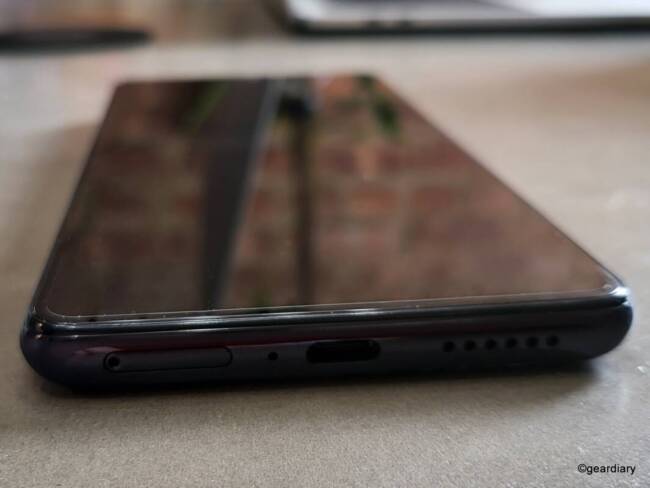
The left side is clean, with no buttons.

The sound that the dual speakers produce is excellent, and it can get quite loud without sounding too tinny; watching movies on this display is an enjoyable experience.

The back of the Xiaomi 11T has a gorgeous, brushed metal design painted under the glass, but be warned: it is a total fingerprint magnet. Since the back is covered in Corning Gorilla Glass 5 (which I have been known to scratch without even trying), you’ll want to keep it in a case, so dealing with fingerprints shouldn’t be too big of a concern unless you prefer to carry your phone naked.
At the upper left, there is a rectangular camera array with two levels. It sticks out enough (about 2mm on the thicker side) that the phone will wobble when it’s lying on its back; in a case, this isn’t an issue.
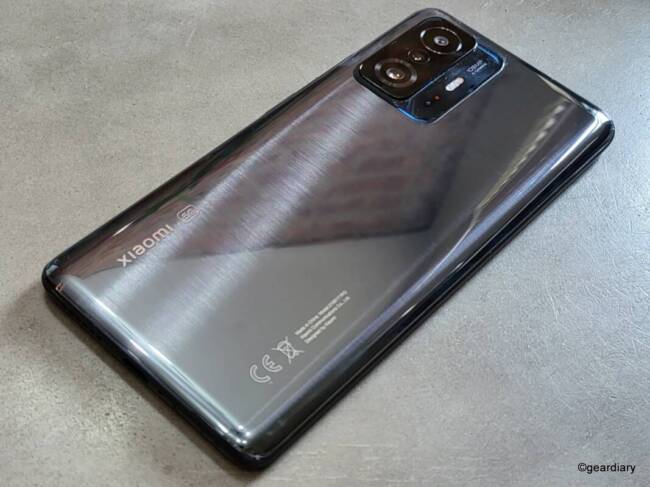
The way the Xiaomi 11T’s camera array is laid out is meant to be reminiscent of a vintage video recorder’s reels; the upper level includes a 108-megapixel wide-angle camera, an 8-megapixel 120º ultra-wide-angle camera, and a 5-megapixel 2X telemacro in a row.
On the lower level, there is the third microphone, a red dot — meant to be reminiscent of the blinking light on a video camera, although unfortunately (or maybe fortunately, depending upon how you look at it), this dot doesn’t glow red when you’re shooting a video. Even so, it’s a cute and nostalgic touch. Next, there is a dual-tone LED flash and a “108MP AI Camera” badge.
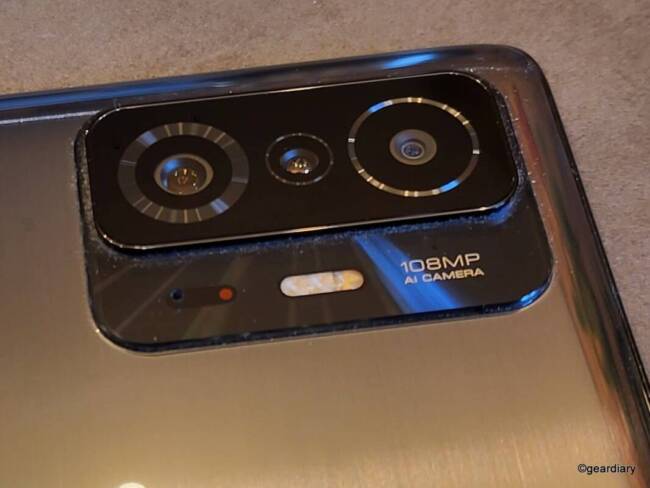
The Xiaomi 11T can record Slow Motion video at 720p at 120 frames per second (fps), and 240fps, 960fps; 1080p video can be filmed at 120 fps. You can also record 4K (3840×2160) video at 30 fps, 1080p (1920×1080) video at 60 fps and 30 fps, and 720p (1280×720) video at 30fps.
Here’s a short video of an NYC street performer singing outside the Manchester Orchestra concert in NYC as it let out on October 21st. With no special effects at all, I thought that the Xiaomi 11T did a very good job.
But the Xiaomi 11T’s cameras are also loaded with plenty of cinematic effects so that you can get more creative with your videos. Where you might otherwise have needed a green screen, multiple takes, and complicated editing software, Xiaomi engineers have introduced what they call “One-Click Cinemagic.”
With the 11T, you’ll have access to tools like Magic Zoom (aka Hitchcock Zoom) — a special effect movie-makers often use to create cinematic suspense. The AI baked into the camera creates hundreds of key points on the fly to enable real-time subject and portrait tracking. The result is an illusion that the world is closing in on your subject by magnifying their tracked portrait.
I’m definitely not a cinematographer, so I’ll give you an example of a video shot using the 11T series by someone who knows what they are doing, using people who know how to act.
Using a third microphone to triangulate the sound of your video subject while minimizing other unwanted surrounding sounds, Audio Zoom gives the realistic effect of sounds getting louder or softer depending upon the direction that you are zooming. We’ve seen this feature in other smartphones before, including the LG V60, Pixel 5, and the OnePlus 9 Pro; it’s also included in the latest iPhones and several higher-end Samsung smartphones.
The way audio zoom works is that when you are recording video, as you zoom into an object — like a car coming down the street, log’s crackling on the fire, or a hibachi chef preparing a meal, for instance — the sounds of the item you are recording will get louder as the subject becomes more prominent. When you zoom out away from your subject, the sounds will recede.
Those are just a few of the Xiaomi 11T’s cinematic tools, so if you’ve ever wanted to do just a little bit more with the video recorder that’s always in your pocket, you’ll have a lot of fun exploring them.
Photos Taken with the Xiaomi Mi 11T
Here are a variety of photos taken with the Xiaomi 11T. The phone’s cameras can zoom from 0.6X to 10X, and you’ll notice that it can get pretty grainy when on max zoom, but to be fair, most smartphones do the same. For the most part, the cameras seem very good, if not. Click the first photo, and a gallery will open.
- Street scene in NYC.
- Zooming in on the Empire State Building. A zoomed pic like this at night would probably benefit from a tripod; all I had was my shaky hand, so …
- Zooming in on Leah Wellbaum of Slothrust.
- Manchester Orchestra stage before they entered.
- Full Zoom on Andy Hull of Manchester Orchestra.
- Wide-angle shot of Manchester Orchestra.
- Ultra-wide-angle shot of Manchester Orchestra.
- Wide Angel shot of Manchester Orchestra.
- Ultra-wide-angle shot of Manchester Orchestra.
- Wide Angele Shot of Manchester Orchestra.
- Zooming in on Manchester Orchestra.
- About to cook dinner at a friend’s house.
- We realized after the fact that we used the wrong type of wrappers for the lumpia; it was still delicious. haha
- Prepping one of the four entrees we made that night.
- Fresh veggies for the Pancit.
- Tell me that’s not the coolest plant pot!
- Our wonderful host, MJ.
- Kev observed as MJ and I cooked.
- Fall is coming to NYC.
- Foliage is turning.
- Buttons is not amused.
Xiaomi Mi 11T Speed, Battery Life
You can purchase the Xiaomi 11T with either 8GB RAM and 128GB user memory or 8GB RAM and 256GB user memory, and the 11T uses the MediaTek Dimensity 1200-Ultra 5G SoC. I never felt any lag or drag, and the chip could handle everything that I threw at it, including a ridiculous amount of open Chrome tabs, light gaming, and taking photos without a lag. The games I play aren’t that processor-intensive, so I can’t speak to how it would perform in that scenario, but I found the phone responsive and capable.
There are two 2,500mAh batteries inside the 11T for a combined 5,000mAh total. Battery life on this phone has been surprisingly good, considering that it has such a large display with up to a 120Hx refresh rate! At the 60Hz refresh rate, I can easily get a full day of typical use out of it, which includes a lot of reading, messaging, listening to music, and surfing.
Out of the box, the phone comes set to 60Hz, so if you want the smoothest experience, you’ll need to go into Settings/Display and select I keep the refresh rate to 120Hz, and I haven’t noticed much of a battery life ding. On lighter use days, the battery is still at 40 to 50% the following mid-morning, so I have no complaints. I suspect that most people will be very satisfied with the phone’s overall battery life.
The Xiaomi 11T doesn’t have wireless charging, but it does charge quite quickly with a PD external battery pack or any laptop’s USB-C charger. With the included EU 65W wall charger, Xiaomi says that the 11T will reach a 100% charge in 36 minutes.
The phone comes with Android 11 with Xiaomi’s MiUI 12.5 overlay. I covered their UI extensively in the Xiaomi Mi 11 Lite 4G review, so you might want to check that out. While the stock UI on the Google Pixel remains my favorite, this overlay isn’t terrible, and the personalization options are fun. I do like that swiping down on the top left will bring up notifications only, and swiping down on the top right will bring up your settings and smart devices separately; if you are familiar with iOS, you will immediately get it.
Worth noting is that Xiaomi promises three years of Android OS updates and four years of security patches.
As this is a 5G capable phone, assuming that you have 5G in your area, you’ll want to ensure that the Xiaomi 11T’s bands are compatible with your carrier.
| Carriers | 5G Bands | 5G Frequencies |
| AT&T | n5, n260 | 850, 1900, 39 GHz (mmWave) |
| Verizon | n2, n5, n40, n260, n261, n266 | 850, 1700, 1900, 28 GHz (mmWave), 39 GHz (mmWave) |
| T-Mobile/Sprint | n71, n41, n261, n260 | 600, 2500, 28 GHz (mmWave), 39 GHz (mmWave) |
The Xiaomi 11T is compatible with the following bands; if they are on the list above, I have them highlighted:
- 5G: n1/n3/n5/n7/n8/n20/n28/n38/n40/n41/n66/n77/n78.
- 4G: FDD-LTE: B1/2/3/4/5/7/8/12/13/17/18/19/20/26/28/32/66.
- 4G: LTE TDD: B38/40/41/42.
With its excellent display, Dolby Atmos sound, great cameras, all-day battery life, fast MediaTek Dimensity 1200 processor, and IP53 splash resistance, the Xiaomi 11T is a great option if you are ready to try something new. Get to know Xiaomi; you’ll be glad that you did!
You can learn more about the Xiaomi 11T here, and you can read its full specifications here.
The Xiaomi 11T retail pricing starts at €499; it is not officially for sale in the US, but you can find it on eBay from several top-rated sellers, currently including never-msrp, megamobilesales.
Source: Manufacturer supplied review sample
What I Like: Solid build; Beautiful and bright 6.67″ AMOLED Gorilla Glass Victus display; Excellent battery life; Fingerprint reader built into the power button is very accurate and can be set for touch or press activation; Facial recognition works very well; Choice of 60Hz or 120Hz refresh rate; Dual SIM; IP53 dust and water resistance; Xiaomi is promising three years of Android OS updates and four years of security patches
What Needs Improvement: No wireless charging



























This seems to be a great device at a very reasonable price. I would have thought that the main reason for having a 108 MP camera would be so you could use high digital zoom, though here, I guess it would use the telemacro camera when you zoom in.